University Finance Project: Global Mergers and Acquisitions Analysis
VerifiedAdded on 2023/05/28
|38
|12022
|340
Project
AI Summary
This project analyzes mergers and acquisitions (M&A) as a crucial corporate strategy in the global business environment. Section 1 delves into the definition of successful M&A, exploring the selection process, key characteristics of successful deals, and necessary improvements to enhance success rates. It examines the long-term impacts of M&A. The project covers the selection process involving market analysis, candidate identification, strategic fit assessment, decision-making, valuation, due diligence, and post-merger integration. Section 2 then considers the impact of CSR, Accountability and Governance of Firm Performance, and Mergers and Acquisitions – Its impact on Management and Employees. The project emphasizes that successful organizations engage in strategic planning, careful due diligence, and integration planning to maximize value and minimize disruption. The project concludes by highlighting the importance of adaptability and a comprehensive approach to M&A for achieving sustainable success. The assignment follows the project guidelines and requirements given in the brief.

Running head: FINANCE
Finance
Name of the Student:
Name of the University:
Author’s Note:
Course ID:
Finance
Name of the Student:
Name of the University:
Author’s Note:
Course ID:
Paraphrase This Document
Need a fresh take? Get an instant paraphrase of this document with our AI Paraphraser
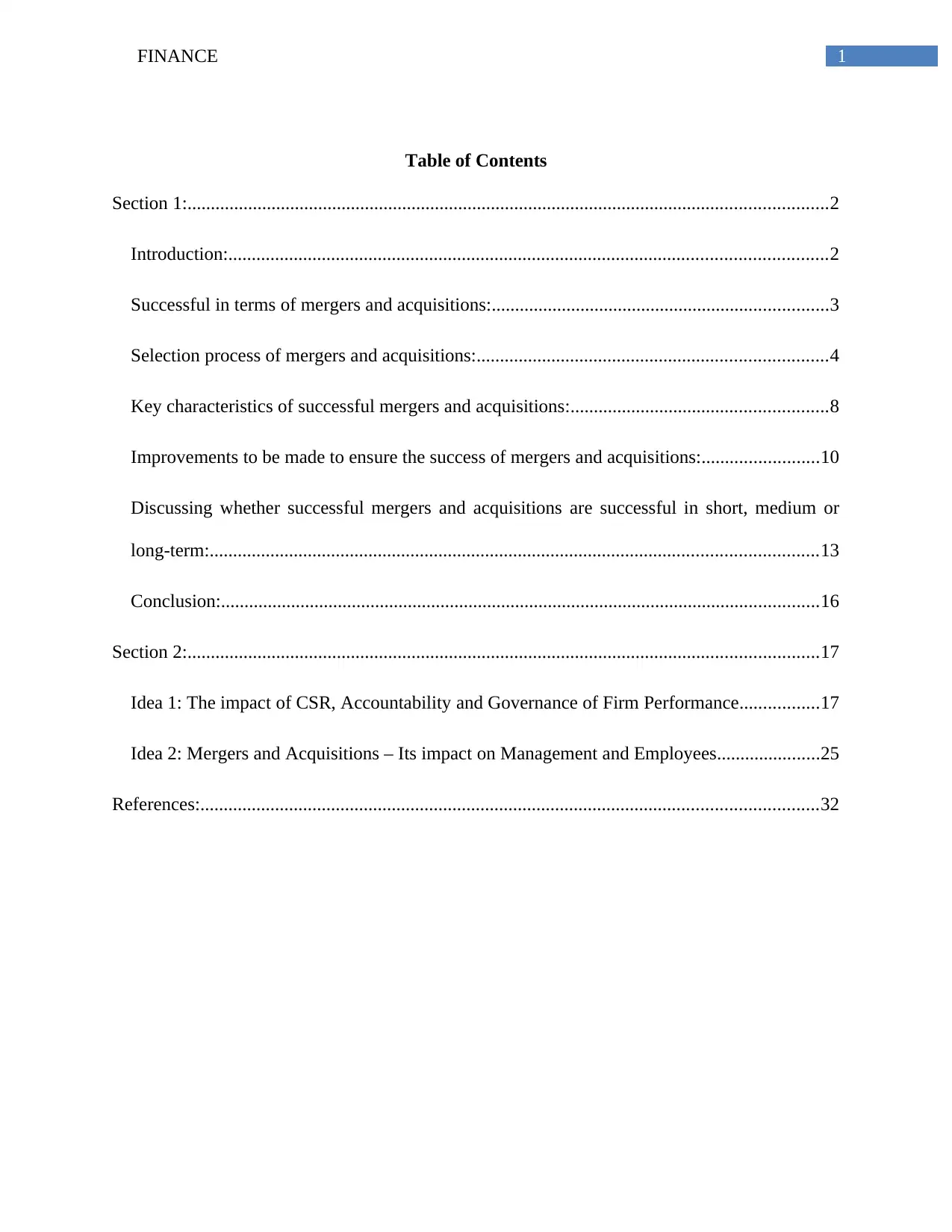
1FINANCE
Table of Contents
Section 1:.........................................................................................................................................2
Introduction:................................................................................................................................2
Successful in terms of mergers and acquisitions:........................................................................3
Selection process of mergers and acquisitions:...........................................................................4
Key characteristics of successful mergers and acquisitions:.......................................................8
Improvements to be made to ensure the success of mergers and acquisitions:.........................10
Discussing whether successful mergers and acquisitions are successful in short, medium or
long-term:..................................................................................................................................13
Conclusion:................................................................................................................................16
Section 2:.......................................................................................................................................17
Idea 1: The impact of CSR, Accountability and Governance of Firm Performance.................17
Idea 2: Mergers and Acquisitions – Its impact on Management and Employees......................25
References:....................................................................................................................................32
Table of Contents
Section 1:.........................................................................................................................................2
Introduction:................................................................................................................................2
Successful in terms of mergers and acquisitions:........................................................................3
Selection process of mergers and acquisitions:...........................................................................4
Key characteristics of successful mergers and acquisitions:.......................................................8
Improvements to be made to ensure the success of mergers and acquisitions:.........................10
Discussing whether successful mergers and acquisitions are successful in short, medium or
long-term:..................................................................................................................................13
Conclusion:................................................................................................................................16
Section 2:.......................................................................................................................................17
Idea 1: The impact of CSR, Accountability and Governance of Firm Performance.................17
Idea 2: Mergers and Acquisitions – Its impact on Management and Employees......................25
References:....................................................................................................................................32
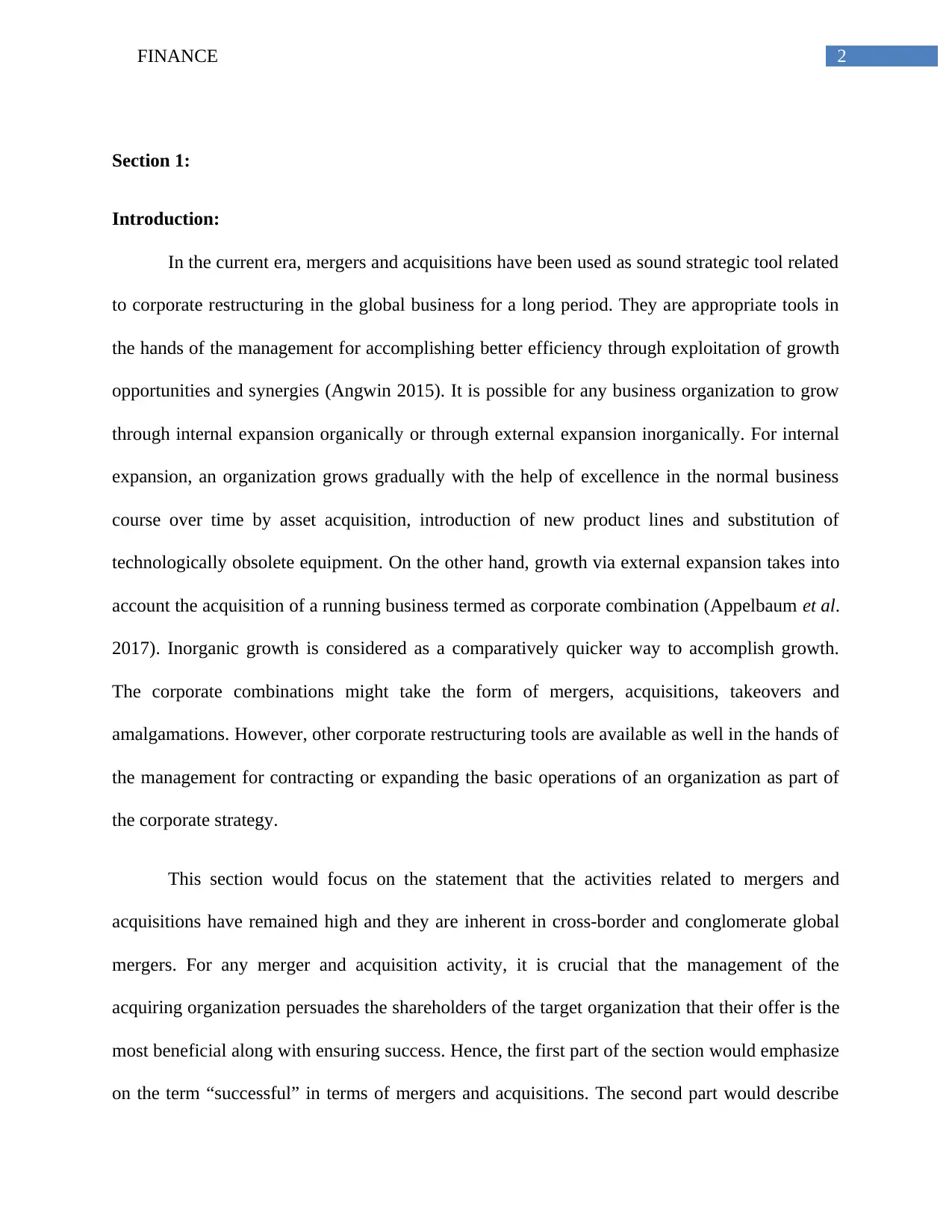
2FINANCE
Section 1:
Introduction:
In the current era, mergers and acquisitions have been used as sound strategic tool related
to corporate restructuring in the global business for a long period. They are appropriate tools in
the hands of the management for accomplishing better efficiency through exploitation of growth
opportunities and synergies (Angwin 2015). It is possible for any business organization to grow
through internal expansion organically or through external expansion inorganically. For internal
expansion, an organization grows gradually with the help of excellence in the normal business
course over time by asset acquisition, introduction of new product lines and substitution of
technologically obsolete equipment. On the other hand, growth via external expansion takes into
account the acquisition of a running business termed as corporate combination (Appelbaum et al.
2017). Inorganic growth is considered as a comparatively quicker way to accomplish growth.
The corporate combinations might take the form of mergers, acquisitions, takeovers and
amalgamations. However, other corporate restructuring tools are available as well in the hands of
the management for contracting or expanding the basic operations of an organization as part of
the corporate strategy.
This section would focus on the statement that the activities related to mergers and
acquisitions have remained high and they are inherent in cross-border and conglomerate global
mergers. For any merger and acquisition activity, it is crucial that the management of the
acquiring organization persuades the shareholders of the target organization that their offer is the
most beneficial along with ensuring success. Hence, the first part of the section would emphasize
on the term “successful” in terms of mergers and acquisitions. The second part would describe
Section 1:
Introduction:
In the current era, mergers and acquisitions have been used as sound strategic tool related
to corporate restructuring in the global business for a long period. They are appropriate tools in
the hands of the management for accomplishing better efficiency through exploitation of growth
opportunities and synergies (Angwin 2015). It is possible for any business organization to grow
through internal expansion organically or through external expansion inorganically. For internal
expansion, an organization grows gradually with the help of excellence in the normal business
course over time by asset acquisition, introduction of new product lines and substitution of
technologically obsolete equipment. On the other hand, growth via external expansion takes into
account the acquisition of a running business termed as corporate combination (Appelbaum et al.
2017). Inorganic growth is considered as a comparatively quicker way to accomplish growth.
The corporate combinations might take the form of mergers, acquisitions, takeovers and
amalgamations. However, other corporate restructuring tools are available as well in the hands of
the management for contracting or expanding the basic operations of an organization as part of
the corporate strategy.
This section would focus on the statement that the activities related to mergers and
acquisitions have remained high and they are inherent in cross-border and conglomerate global
mergers. For any merger and acquisition activity, it is crucial that the management of the
acquiring organization persuades the shareholders of the target organization that their offer is the
most beneficial along with ensuring success. Hence, the first part of the section would emphasize
on the term “successful” in terms of mergers and acquisitions. The second part would describe
⊘ This is a preview!⊘
Do you want full access?
Subscribe today to unlock all pages.

Trusted by 1+ million students worldwide
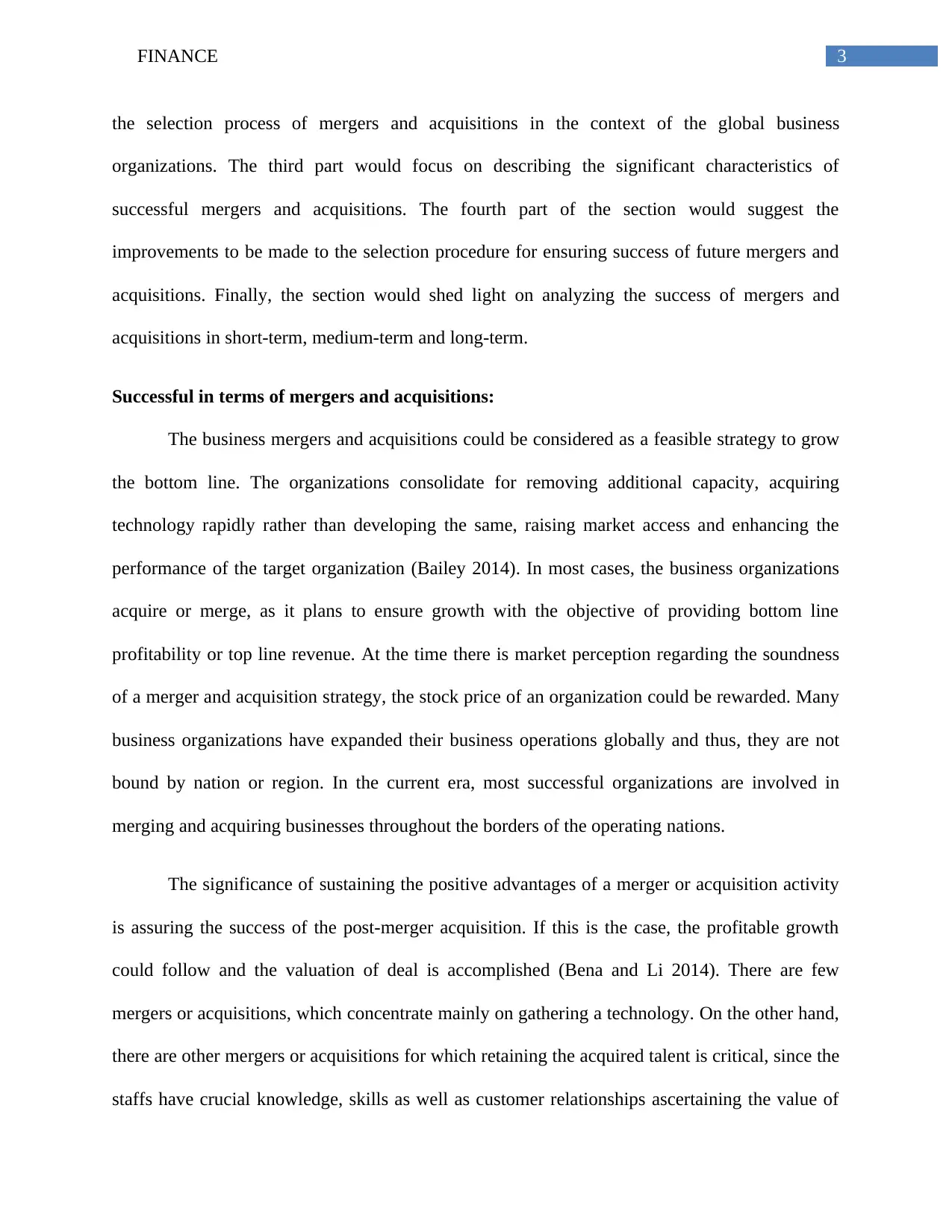
3FINANCE
the selection process of mergers and acquisitions in the context of the global business
organizations. The third part would focus on describing the significant characteristics of
successful mergers and acquisitions. The fourth part of the section would suggest the
improvements to be made to the selection procedure for ensuring success of future mergers and
acquisitions. Finally, the section would shed light on analyzing the success of mergers and
acquisitions in short-term, medium-term and long-term.
Successful in terms of mergers and acquisitions:
The business mergers and acquisitions could be considered as a feasible strategy to grow
the bottom line. The organizations consolidate for removing additional capacity, acquiring
technology rapidly rather than developing the same, raising market access and enhancing the
performance of the target organization (Bailey 2014). In most cases, the business organizations
acquire or merge, as it plans to ensure growth with the objective of providing bottom line
profitability or top line revenue. At the time there is market perception regarding the soundness
of a merger and acquisition strategy, the stock price of an organization could be rewarded. Many
business organizations have expanded their business operations globally and thus, they are not
bound by nation or region. In the current era, most successful organizations are involved in
merging and acquiring businesses throughout the borders of the operating nations.
The significance of sustaining the positive advantages of a merger or acquisition activity
is assuring the success of the post-merger acquisition. If this is the case, the profitable growth
could follow and the valuation of deal is accomplished (Bena and Li 2014). There are few
mergers or acquisitions, which concentrate mainly on gathering a technology. On the other hand,
there are other mergers or acquisitions for which retaining the acquired talent is critical, since the
staffs have crucial knowledge, skills as well as customer relationships ascertaining the value of
the selection process of mergers and acquisitions in the context of the global business
organizations. The third part would focus on describing the significant characteristics of
successful mergers and acquisitions. The fourth part of the section would suggest the
improvements to be made to the selection procedure for ensuring success of future mergers and
acquisitions. Finally, the section would shed light on analyzing the success of mergers and
acquisitions in short-term, medium-term and long-term.
Successful in terms of mergers and acquisitions:
The business mergers and acquisitions could be considered as a feasible strategy to grow
the bottom line. The organizations consolidate for removing additional capacity, acquiring
technology rapidly rather than developing the same, raising market access and enhancing the
performance of the target organization (Bailey 2014). In most cases, the business organizations
acquire or merge, as it plans to ensure growth with the objective of providing bottom line
profitability or top line revenue. At the time there is market perception regarding the soundness
of a merger and acquisition strategy, the stock price of an organization could be rewarded. Many
business organizations have expanded their business operations globally and thus, they are not
bound by nation or region. In the current era, most successful organizations are involved in
merging and acquiring businesses throughout the borders of the operating nations.
The significance of sustaining the positive advantages of a merger or acquisition activity
is assuring the success of the post-merger acquisition. If this is the case, the profitable growth
could follow and the valuation of deal is accomplished (Bena and Li 2014). There are few
mergers or acquisitions, which concentrate mainly on gathering a technology. On the other hand,
there are other mergers or acquisitions for which retaining the acquired talent is critical, since the
staffs have crucial knowledge, skills as well as customer relationships ascertaining the value of
Paraphrase This Document
Need a fresh take? Get an instant paraphrase of this document with our AI Paraphraser
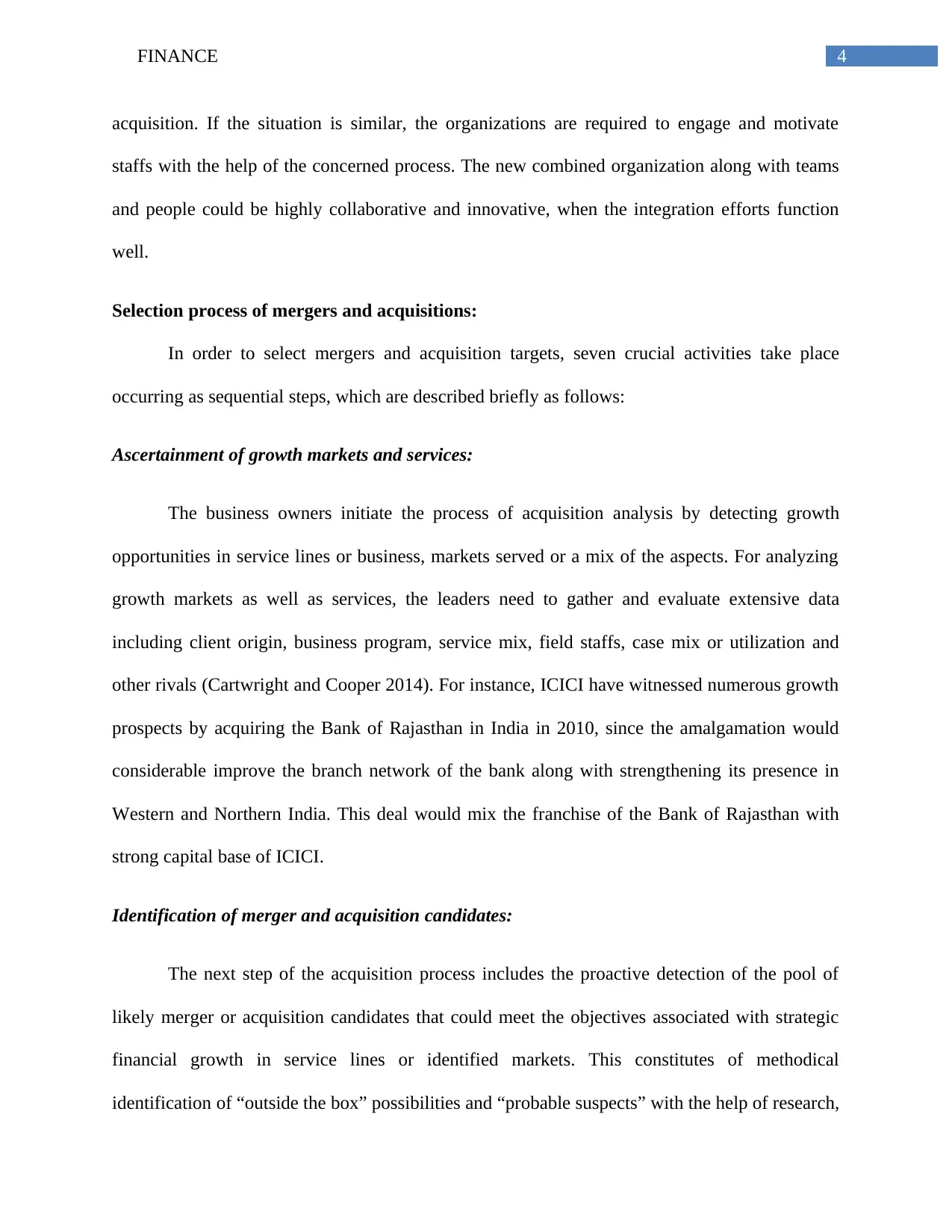
4FINANCE
acquisition. If the situation is similar, the organizations are required to engage and motivate
staffs with the help of the concerned process. The new combined organization along with teams
and people could be highly collaborative and innovative, when the integration efforts function
well.
Selection process of mergers and acquisitions:
In order to select mergers and acquisition targets, seven crucial activities take place
occurring as sequential steps, which are described briefly as follows:
Ascertainment of growth markets and services:
The business owners initiate the process of acquisition analysis by detecting growth
opportunities in service lines or business, markets served or a mix of the aspects. For analyzing
growth markets as well as services, the leaders need to gather and evaluate extensive data
including client origin, business program, service mix, field staffs, case mix or utilization and
other rivals (Cartwright and Cooper 2014). For instance, ICICI have witnessed numerous growth
prospects by acquiring the Bank of Rajasthan in India in 2010, since the amalgamation would
considerable improve the branch network of the bank along with strengthening its presence in
Western and Northern India. This deal would mix the franchise of the Bank of Rajasthan with
strong capital base of ICICI.
Identification of merger and acquisition candidates:
The next step of the acquisition process includes the proactive detection of the pool of
likely merger or acquisition candidates that could meet the objectives associated with strategic
financial growth in service lines or identified markets. This constitutes of methodical
identification of “outside the box” possibilities and “probable suspects” with the help of research,
acquisition. If the situation is similar, the organizations are required to engage and motivate
staffs with the help of the concerned process. The new combined organization along with teams
and people could be highly collaborative and innovative, when the integration efforts function
well.
Selection process of mergers and acquisitions:
In order to select mergers and acquisition targets, seven crucial activities take place
occurring as sequential steps, which are described briefly as follows:
Ascertainment of growth markets and services:
The business owners initiate the process of acquisition analysis by detecting growth
opportunities in service lines or business, markets served or a mix of the aspects. For analyzing
growth markets as well as services, the leaders need to gather and evaluate extensive data
including client origin, business program, service mix, field staffs, case mix or utilization and
other rivals (Cartwright and Cooper 2014). For instance, ICICI have witnessed numerous growth
prospects by acquiring the Bank of Rajasthan in India in 2010, since the amalgamation would
considerable improve the branch network of the bank along with strengthening its presence in
Western and Northern India. This deal would mix the franchise of the Bank of Rajasthan with
strong capital base of ICICI.
Identification of merger and acquisition candidates:
The next step of the acquisition process includes the proactive detection of the pool of
likely merger or acquisition candidates that could meet the objectives associated with strategic
financial growth in service lines or identified markets. This constitutes of methodical
identification of “outside the box” possibilities and “probable suspects” with the help of research,
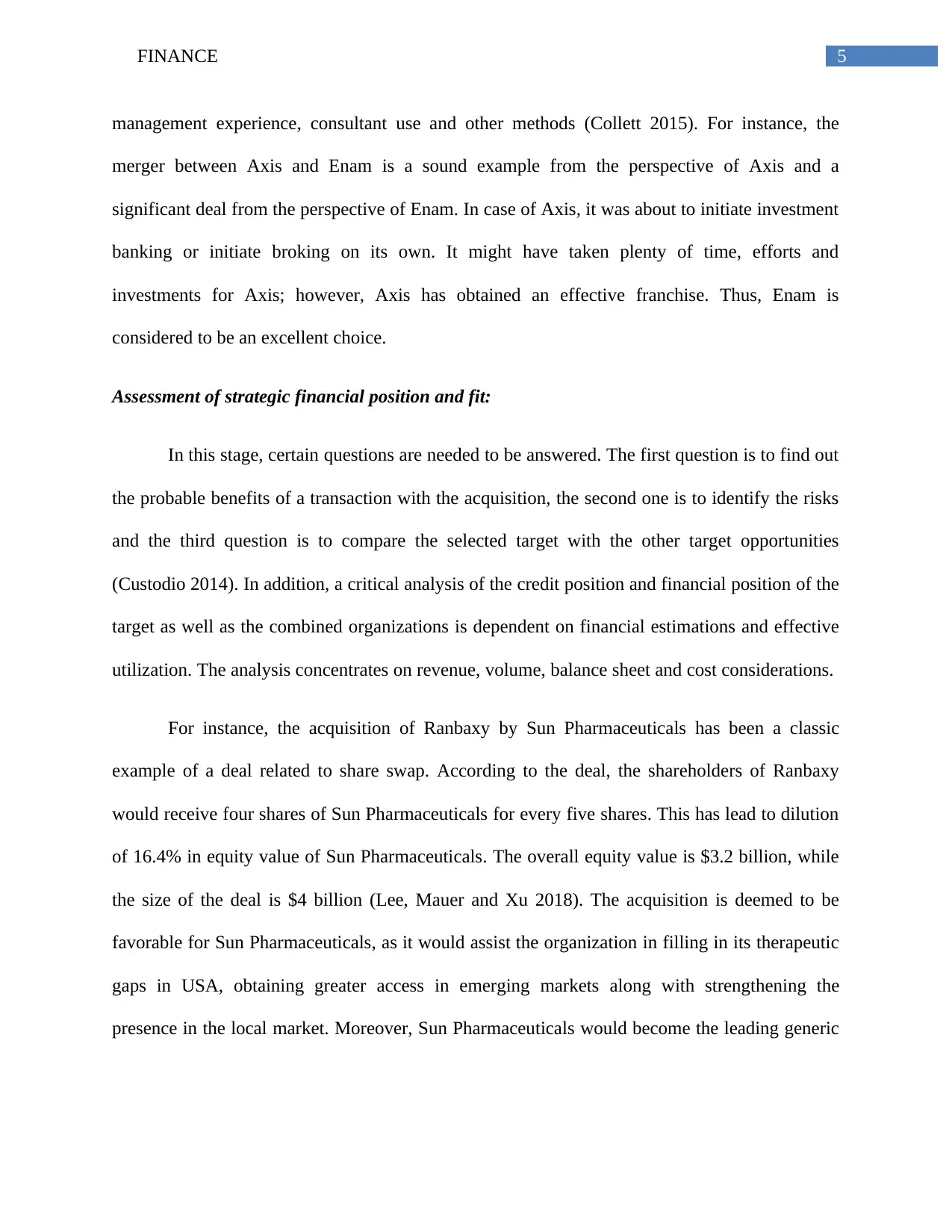
5FINANCE
management experience, consultant use and other methods (Collett 2015). For instance, the
merger between Axis and Enam is a sound example from the perspective of Axis and a
significant deal from the perspective of Enam. In case of Axis, it was about to initiate investment
banking or initiate broking on its own. It might have taken plenty of time, efforts and
investments for Axis; however, Axis has obtained an effective franchise. Thus, Enam is
considered to be an excellent choice.
Assessment of strategic financial position and fit:
In this stage, certain questions are needed to be answered. The first question is to find out
the probable benefits of a transaction with the acquisition, the second one is to identify the risks
and the third question is to compare the selected target with the other target opportunities
(Custodio 2014). In addition, a critical analysis of the credit position and financial position of the
target as well as the combined organizations is dependent on financial estimations and effective
utilization. The analysis concentrates on revenue, volume, balance sheet and cost considerations.
For instance, the acquisition of Ranbaxy by Sun Pharmaceuticals has been a classic
example of a deal related to share swap. According to the deal, the shareholders of Ranbaxy
would receive four shares of Sun Pharmaceuticals for every five shares. This has lead to dilution
of 16.4% in equity value of Sun Pharmaceuticals. The overall equity value is $3.2 billion, while
the size of the deal is $4 billion (Lee, Mauer and Xu 2018). The acquisition is deemed to be
favorable for Sun Pharmaceuticals, as it would assist the organization in filling in its therapeutic
gaps in USA, obtaining greater access in emerging markets along with strengthening the
presence in the local market. Moreover, Sun Pharmaceuticals would become the leading generic
management experience, consultant use and other methods (Collett 2015). For instance, the
merger between Axis and Enam is a sound example from the perspective of Axis and a
significant deal from the perspective of Enam. In case of Axis, it was about to initiate investment
banking or initiate broking on its own. It might have taken plenty of time, efforts and
investments for Axis; however, Axis has obtained an effective franchise. Thus, Enam is
considered to be an excellent choice.
Assessment of strategic financial position and fit:
In this stage, certain questions are needed to be answered. The first question is to find out
the probable benefits of a transaction with the acquisition, the second one is to identify the risks
and the third question is to compare the selected target with the other target opportunities
(Custodio 2014). In addition, a critical analysis of the credit position and financial position of the
target as well as the combined organizations is dependent on financial estimations and effective
utilization. The analysis concentrates on revenue, volume, balance sheet and cost considerations.
For instance, the acquisition of Ranbaxy by Sun Pharmaceuticals has been a classic
example of a deal related to share swap. According to the deal, the shareholders of Ranbaxy
would receive four shares of Sun Pharmaceuticals for every five shares. This has lead to dilution
of 16.4% in equity value of Sun Pharmaceuticals. The overall equity value is $3.2 billion, while
the size of the deal is $4 billion (Lee, Mauer and Xu 2018). The acquisition is deemed to be
favorable for Sun Pharmaceuticals, as it would assist the organization in filling in its therapeutic
gaps in USA, obtaining greater access in emerging markets along with strengthening the
presence in the local market. Moreover, Sun Pharmaceuticals would become the leading generic
⊘ This is a preview!⊘
Do you want full access?
Subscribe today to unlock all pages.

Trusted by 1+ million students worldwide
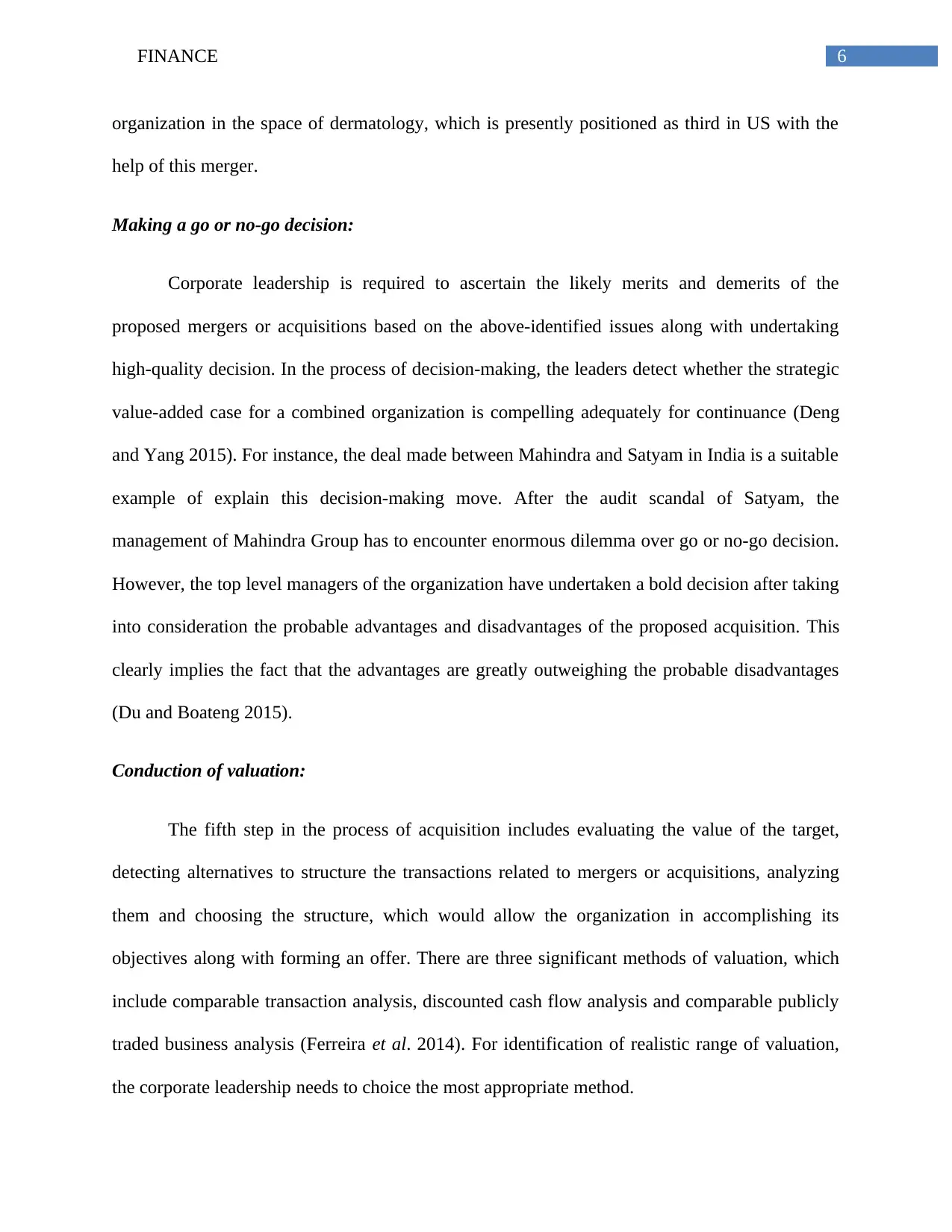
6FINANCE
organization in the space of dermatology, which is presently positioned as third in US with the
help of this merger.
Making a go or no-go decision:
Corporate leadership is required to ascertain the likely merits and demerits of the
proposed mergers or acquisitions based on the above-identified issues along with undertaking
high-quality decision. In the process of decision-making, the leaders detect whether the strategic
value-added case for a combined organization is compelling adequately for continuance (Deng
and Yang 2015). For instance, the deal made between Mahindra and Satyam in India is a suitable
example of explain this decision-making move. After the audit scandal of Satyam, the
management of Mahindra Group has to encounter enormous dilemma over go or no-go decision.
However, the top level managers of the organization have undertaken a bold decision after taking
into consideration the probable advantages and disadvantages of the proposed acquisition. This
clearly implies the fact that the advantages are greatly outweighing the probable disadvantages
(Du and Boateng 2015).
Conduction of valuation:
The fifth step in the process of acquisition includes evaluating the value of the target,
detecting alternatives to structure the transactions related to mergers or acquisitions, analyzing
them and choosing the structure, which would allow the organization in accomplishing its
objectives along with forming an offer. There are three significant methods of valuation, which
include comparable transaction analysis, discounted cash flow analysis and comparable publicly
traded business analysis (Ferreira et al. 2014). For identification of realistic range of valuation,
the corporate leadership needs to choice the most appropriate method.
organization in the space of dermatology, which is presently positioned as third in US with the
help of this merger.
Making a go or no-go decision:
Corporate leadership is required to ascertain the likely merits and demerits of the
proposed mergers or acquisitions based on the above-identified issues along with undertaking
high-quality decision. In the process of decision-making, the leaders detect whether the strategic
value-added case for a combined organization is compelling adequately for continuance (Deng
and Yang 2015). For instance, the deal made between Mahindra and Satyam in India is a suitable
example of explain this decision-making move. After the audit scandal of Satyam, the
management of Mahindra Group has to encounter enormous dilemma over go or no-go decision.
However, the top level managers of the organization have undertaken a bold decision after taking
into consideration the probable advantages and disadvantages of the proposed acquisition. This
clearly implies the fact that the advantages are greatly outweighing the probable disadvantages
(Du and Boateng 2015).
Conduction of valuation:
The fifth step in the process of acquisition includes evaluating the value of the target,
detecting alternatives to structure the transactions related to mergers or acquisitions, analyzing
them and choosing the structure, which would allow the organization in accomplishing its
objectives along with forming an offer. There are three significant methods of valuation, which
include comparable transaction analysis, discounted cash flow analysis and comparable publicly
traded business analysis (Ferreira et al. 2014). For identification of realistic range of valuation,
the corporate leadership needs to choice the most appropriate method.
Paraphrase This Document
Need a fresh take? Get an instant paraphrase of this document with our AI Paraphraser
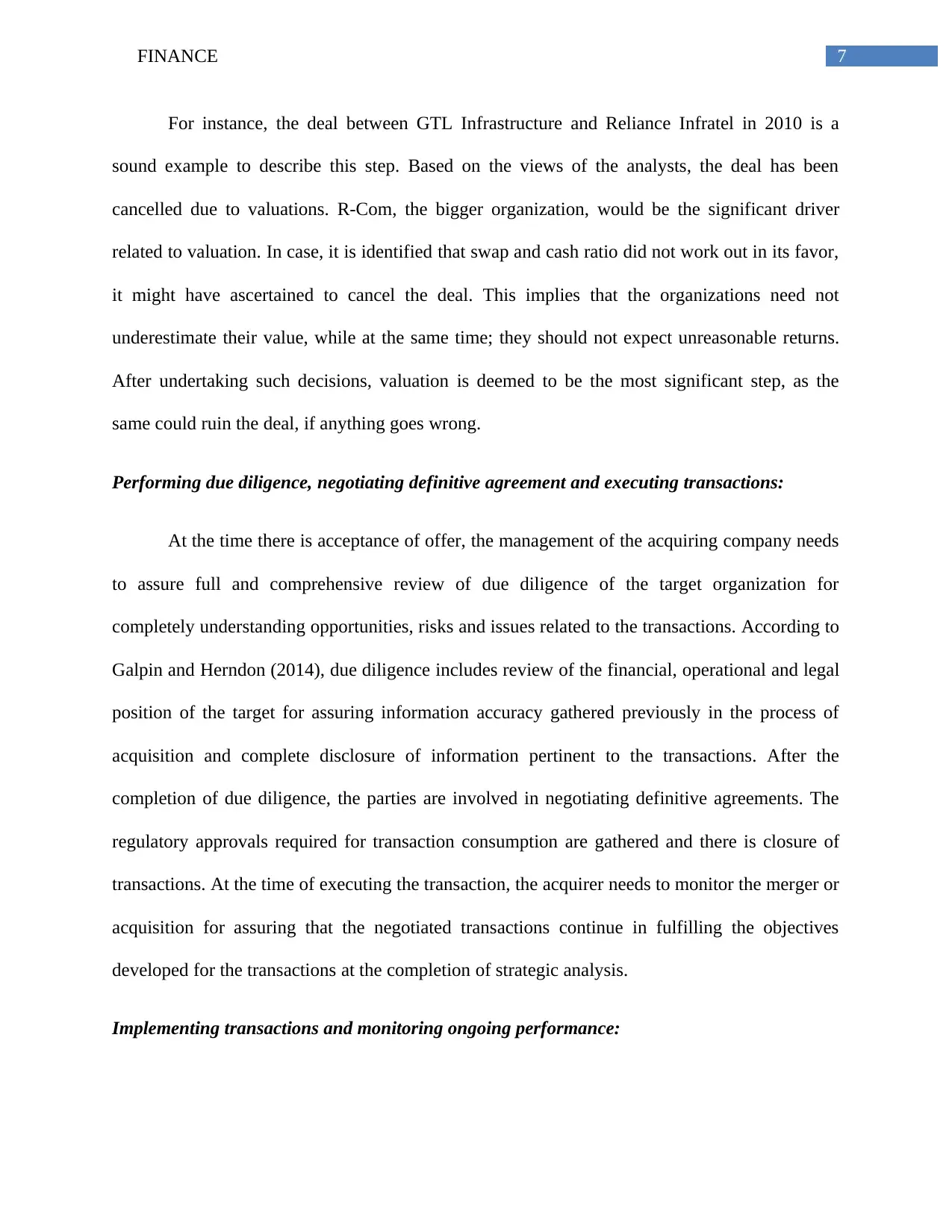
7FINANCE
For instance, the deal between GTL Infrastructure and Reliance Infratel in 2010 is a
sound example to describe this step. Based on the views of the analysts, the deal has been
cancelled due to valuations. R-Com, the bigger organization, would be the significant driver
related to valuation. In case, it is identified that swap and cash ratio did not work out in its favor,
it might have ascertained to cancel the deal. This implies that the organizations need not
underestimate their value, while at the same time; they should not expect unreasonable returns.
After undertaking such decisions, valuation is deemed to be the most significant step, as the
same could ruin the deal, if anything goes wrong.
Performing due diligence, negotiating definitive agreement and executing transactions:
At the time there is acceptance of offer, the management of the acquiring company needs
to assure full and comprehensive review of due diligence of the target organization for
completely understanding opportunities, risks and issues related to the transactions. According to
Galpin and Herndon (2014), due diligence includes review of the financial, operational and legal
position of the target for assuring information accuracy gathered previously in the process of
acquisition and complete disclosure of information pertinent to the transactions. After the
completion of due diligence, the parties are involved in negotiating definitive agreements. The
regulatory approvals required for transaction consumption are gathered and there is closure of
transactions. At the time of executing the transaction, the acquirer needs to monitor the merger or
acquisition for assuring that the negotiated transactions continue in fulfilling the objectives
developed for the transactions at the completion of strategic analysis.
Implementing transactions and monitoring ongoing performance:
For instance, the deal between GTL Infrastructure and Reliance Infratel in 2010 is a
sound example to describe this step. Based on the views of the analysts, the deal has been
cancelled due to valuations. R-Com, the bigger organization, would be the significant driver
related to valuation. In case, it is identified that swap and cash ratio did not work out in its favor,
it might have ascertained to cancel the deal. This implies that the organizations need not
underestimate their value, while at the same time; they should not expect unreasonable returns.
After undertaking such decisions, valuation is deemed to be the most significant step, as the
same could ruin the deal, if anything goes wrong.
Performing due diligence, negotiating definitive agreement and executing transactions:
At the time there is acceptance of offer, the management of the acquiring company needs
to assure full and comprehensive review of due diligence of the target organization for
completely understanding opportunities, risks and issues related to the transactions. According to
Galpin and Herndon (2014), due diligence includes review of the financial, operational and legal
position of the target for assuring information accuracy gathered previously in the process of
acquisition and complete disclosure of information pertinent to the transactions. After the
completion of due diligence, the parties are involved in negotiating definitive agreements. The
regulatory approvals required for transaction consumption are gathered and there is closure of
transactions. At the time of executing the transaction, the acquirer needs to monitor the merger or
acquisition for assuring that the negotiated transactions continue in fulfilling the objectives
developed for the transactions at the completion of strategic analysis.
Implementing transactions and monitoring ongoing performance:
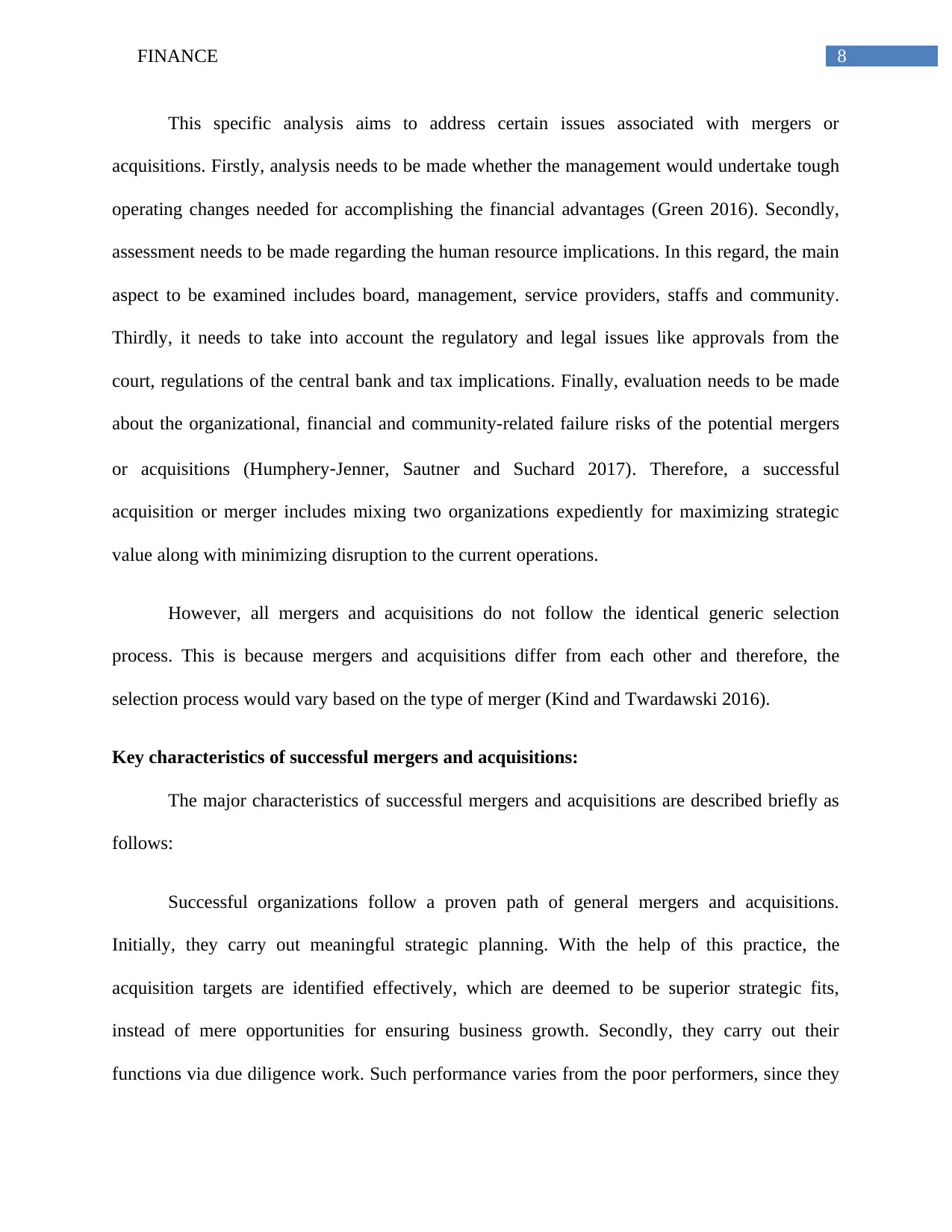
8FINANCE
This specific analysis aims to address certain issues associated with mergers or
acquisitions. Firstly, analysis needs to be made whether the management would undertake tough
operating changes needed for accomplishing the financial advantages (Green 2016). Secondly,
assessment needs to be made regarding the human resource implications. In this regard, the main
aspect to be examined includes board, management, service providers, staffs and community.
Thirdly, it needs to take into account the regulatory and legal issues like approvals from the
court, regulations of the central bank and tax implications. Finally, evaluation needs to be made
about the organizational, financial and community-related failure risks of the potential mergers
or acquisitions (Humphery‐Jenner, Sautner and Suchard 2017). Therefore, a successful
acquisition or merger includes mixing two organizations expediently for maximizing strategic
value along with minimizing disruption to the current operations.
However, all mergers and acquisitions do not follow the identical generic selection
process. This is because mergers and acquisitions differ from each other and therefore, the
selection process would vary based on the type of merger (Kind and Twardawski 2016).
Key characteristics of successful mergers and acquisitions:
The major characteristics of successful mergers and acquisitions are described briefly as
follows:
Successful organizations follow a proven path of general mergers and acquisitions.
Initially, they carry out meaningful strategic planning. With the help of this practice, the
acquisition targets are identified effectively, which are deemed to be superior strategic fits,
instead of mere opportunities for ensuring business growth. Secondly, they carry out their
functions via due diligence work. Such performance varies from the poor performers, since they
This specific analysis aims to address certain issues associated with mergers or
acquisitions. Firstly, analysis needs to be made whether the management would undertake tough
operating changes needed for accomplishing the financial advantages (Green 2016). Secondly,
assessment needs to be made regarding the human resource implications. In this regard, the main
aspect to be examined includes board, management, service providers, staffs and community.
Thirdly, it needs to take into account the regulatory and legal issues like approvals from the
court, regulations of the central bank and tax implications. Finally, evaluation needs to be made
about the organizational, financial and community-related failure risks of the potential mergers
or acquisitions (Humphery‐Jenner, Sautner and Suchard 2017). Therefore, a successful
acquisition or merger includes mixing two organizations expediently for maximizing strategic
value along with minimizing disruption to the current operations.
However, all mergers and acquisitions do not follow the identical generic selection
process. This is because mergers and acquisitions differ from each other and therefore, the
selection process would vary based on the type of merger (Kind and Twardawski 2016).
Key characteristics of successful mergers and acquisitions:
The major characteristics of successful mergers and acquisitions are described briefly as
follows:
Successful organizations follow a proven path of general mergers and acquisitions.
Initially, they carry out meaningful strategic planning. With the help of this practice, the
acquisition targets are identified effectively, which are deemed to be superior strategic fits,
instead of mere opportunities for ensuring business growth. Secondly, they carry out their
functions via due diligence work. Such performance varies from the poor performers, since they
⊘ This is a preview!⊘
Do you want full access?
Subscribe today to unlock all pages.

Trusted by 1+ million students worldwide
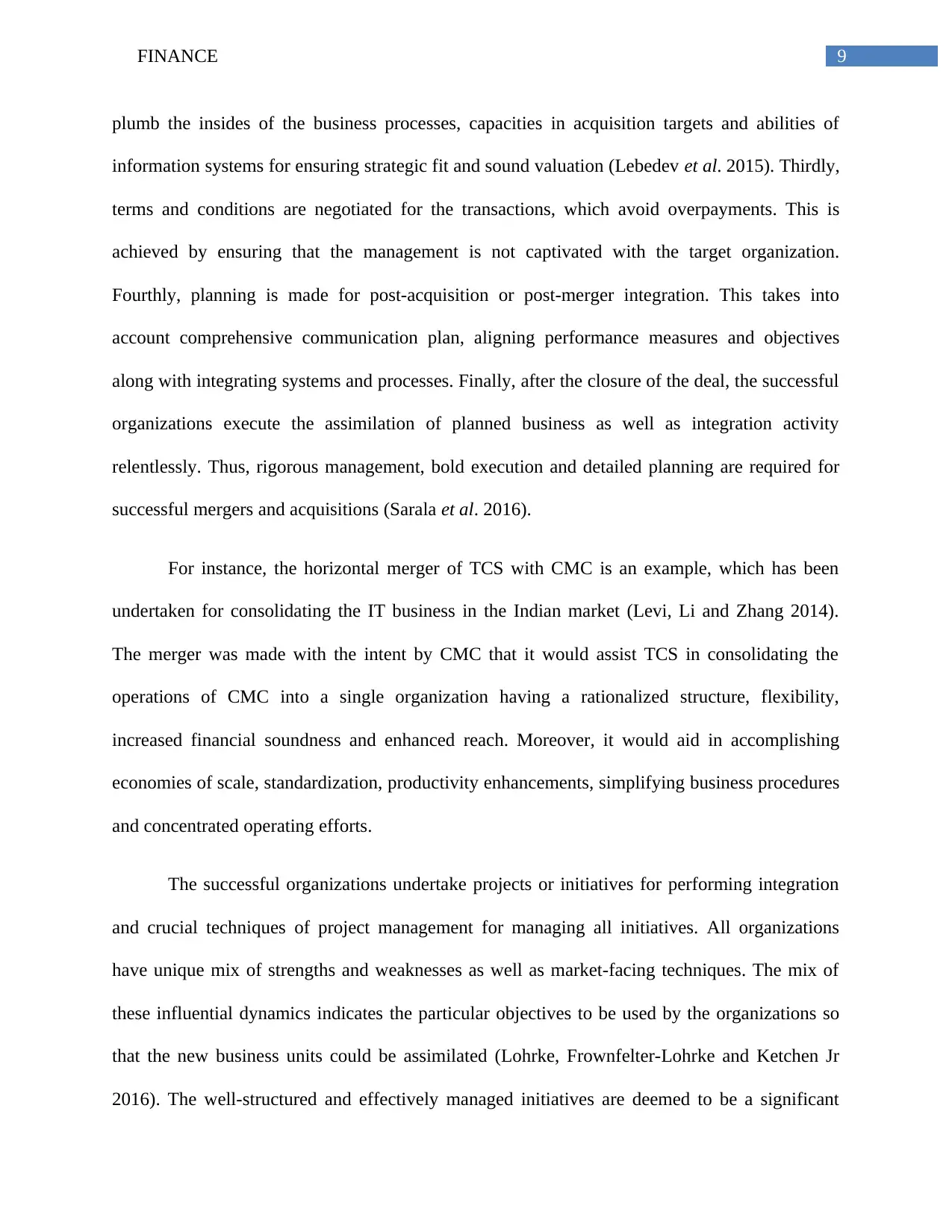
9FINANCE
plumb the insides of the business processes, capacities in acquisition targets and abilities of
information systems for ensuring strategic fit and sound valuation (Lebedev et al. 2015). Thirdly,
terms and conditions are negotiated for the transactions, which avoid overpayments. This is
achieved by ensuring that the management is not captivated with the target organization.
Fourthly, planning is made for post-acquisition or post-merger integration. This takes into
account comprehensive communication plan, aligning performance measures and objectives
along with integrating systems and processes. Finally, after the closure of the deal, the successful
organizations execute the assimilation of planned business as well as integration activity
relentlessly. Thus, rigorous management, bold execution and detailed planning are required for
successful mergers and acquisitions (Sarala et al. 2016).
For instance, the horizontal merger of TCS with CMC is an example, which has been
undertaken for consolidating the IT business in the Indian market (Levi, Li and Zhang 2014).
The merger was made with the intent by CMC that it would assist TCS in consolidating the
operations of CMC into a single organization having a rationalized structure, flexibility,
increased financial soundness and enhanced reach. Moreover, it would aid in accomplishing
economies of scale, standardization, productivity enhancements, simplifying business procedures
and concentrated operating efforts.
The successful organizations undertake projects or initiatives for performing integration
and crucial techniques of project management for managing all initiatives. All organizations
have unique mix of strengths and weaknesses as well as market-facing techniques. The mix of
these influential dynamics indicates the particular objectives to be used by the organizations so
that the new business units could be assimilated (Lohrke, Frownfelter-Lohrke and Ketchen Jr
2016). The well-structured and effectively managed initiatives are deemed to be a significant
plumb the insides of the business processes, capacities in acquisition targets and abilities of
information systems for ensuring strategic fit and sound valuation (Lebedev et al. 2015). Thirdly,
terms and conditions are negotiated for the transactions, which avoid overpayments. This is
achieved by ensuring that the management is not captivated with the target organization.
Fourthly, planning is made for post-acquisition or post-merger integration. This takes into
account comprehensive communication plan, aligning performance measures and objectives
along with integrating systems and processes. Finally, after the closure of the deal, the successful
organizations execute the assimilation of planned business as well as integration activity
relentlessly. Thus, rigorous management, bold execution and detailed planning are required for
successful mergers and acquisitions (Sarala et al. 2016).
For instance, the horizontal merger of TCS with CMC is an example, which has been
undertaken for consolidating the IT business in the Indian market (Levi, Li and Zhang 2014).
The merger was made with the intent by CMC that it would assist TCS in consolidating the
operations of CMC into a single organization having a rationalized structure, flexibility,
increased financial soundness and enhanced reach. Moreover, it would aid in accomplishing
economies of scale, standardization, productivity enhancements, simplifying business procedures
and concentrated operating efforts.
The successful organizations undertake projects or initiatives for performing integration
and crucial techniques of project management for managing all initiatives. All organizations
have unique mix of strengths and weaknesses as well as market-facing techniques. The mix of
these influential dynamics indicates the particular objectives to be used by the organizations so
that the new business units could be assimilated (Lohrke, Frownfelter-Lohrke and Ketchen Jr
2016). The well-structured and effectively managed initiatives are deemed to be a significant
Paraphrase This Document
Need a fresh take? Get an instant paraphrase of this document with our AI Paraphraser
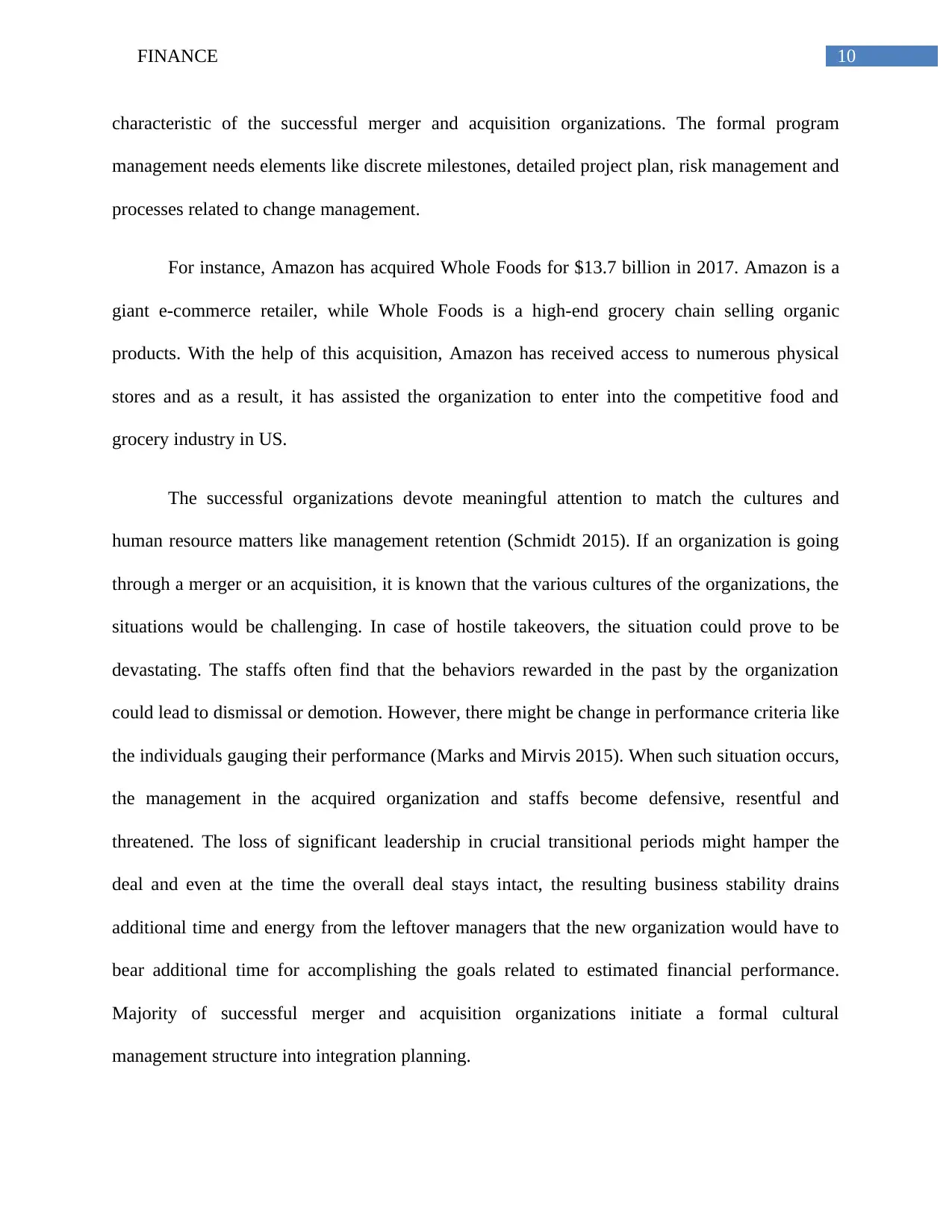
10FINANCE
characteristic of the successful merger and acquisition organizations. The formal program
management needs elements like discrete milestones, detailed project plan, risk management and
processes related to change management.
For instance, Amazon has acquired Whole Foods for $13.7 billion in 2017. Amazon is a
giant e-commerce retailer, while Whole Foods is a high-end grocery chain selling organic
products. With the help of this acquisition, Amazon has received access to numerous physical
stores and as a result, it has assisted the organization to enter into the competitive food and
grocery industry in US.
The successful organizations devote meaningful attention to match the cultures and
human resource matters like management retention (Schmidt 2015). If an organization is going
through a merger or an acquisition, it is known that the various cultures of the organizations, the
situations would be challenging. In case of hostile takeovers, the situation could prove to be
devastating. The staffs often find that the behaviors rewarded in the past by the organization
could lead to dismissal or demotion. However, there might be change in performance criteria like
the individuals gauging their performance (Marks and Mirvis 2015). When such situation occurs,
the management in the acquired organization and staffs become defensive, resentful and
threatened. The loss of significant leadership in crucial transitional periods might hamper the
deal and even at the time the overall deal stays intact, the resulting business stability drains
additional time and energy from the leftover managers that the new organization would have to
bear additional time for accomplishing the goals related to estimated financial performance.
Majority of successful merger and acquisition organizations initiate a formal cultural
management structure into integration planning.
characteristic of the successful merger and acquisition organizations. The formal program
management needs elements like discrete milestones, detailed project plan, risk management and
processes related to change management.
For instance, Amazon has acquired Whole Foods for $13.7 billion in 2017. Amazon is a
giant e-commerce retailer, while Whole Foods is a high-end grocery chain selling organic
products. With the help of this acquisition, Amazon has received access to numerous physical
stores and as a result, it has assisted the organization to enter into the competitive food and
grocery industry in US.
The successful organizations devote meaningful attention to match the cultures and
human resource matters like management retention (Schmidt 2015). If an organization is going
through a merger or an acquisition, it is known that the various cultures of the organizations, the
situations would be challenging. In case of hostile takeovers, the situation could prove to be
devastating. The staffs often find that the behaviors rewarded in the past by the organization
could lead to dismissal or demotion. However, there might be change in performance criteria like
the individuals gauging their performance (Marks and Mirvis 2015). When such situation occurs,
the management in the acquired organization and staffs become defensive, resentful and
threatened. The loss of significant leadership in crucial transitional periods might hamper the
deal and even at the time the overall deal stays intact, the resulting business stability drains
additional time and energy from the leftover managers that the new organization would have to
bear additional time for accomplishing the goals related to estimated financial performance.
Majority of successful merger and acquisition organizations initiate a formal cultural
management structure into integration planning.
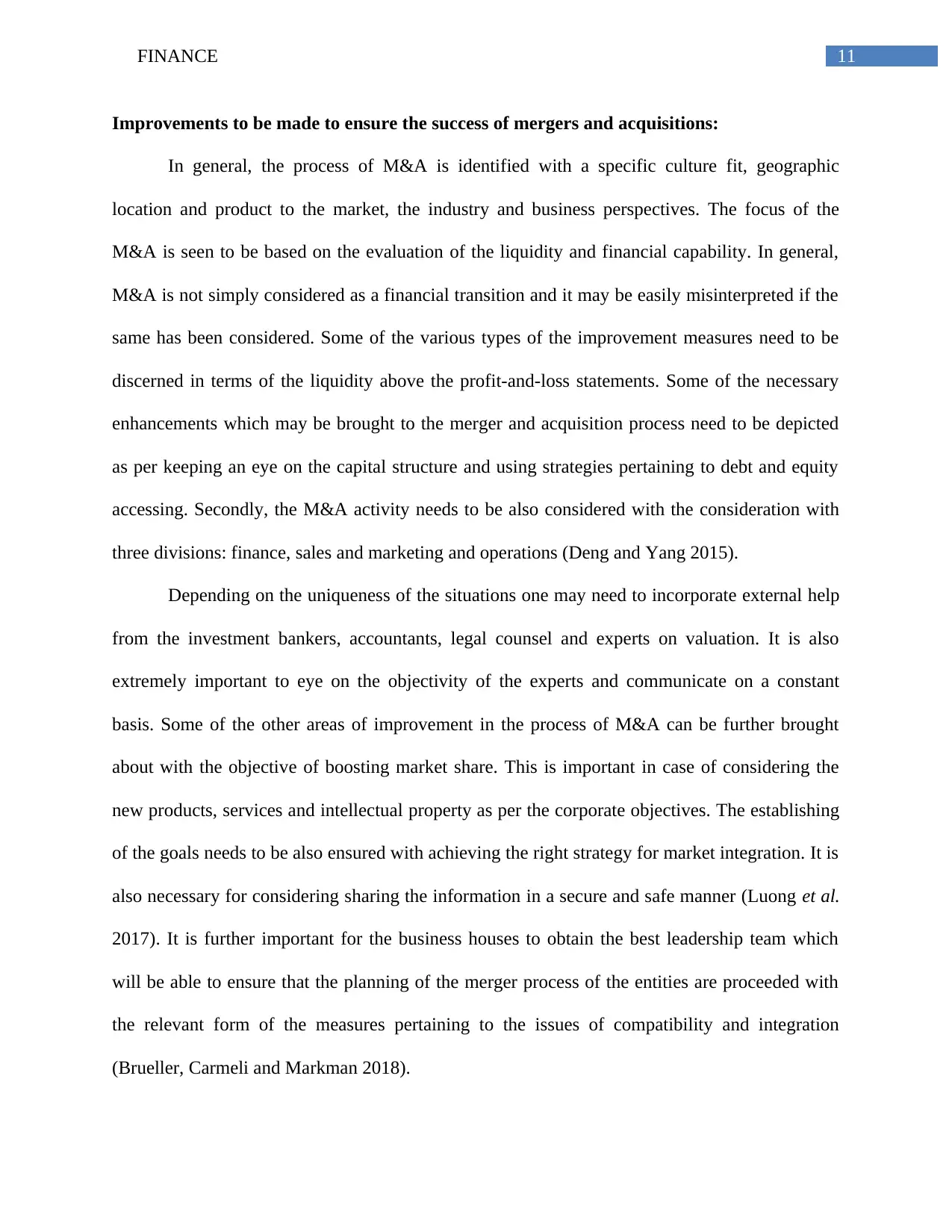
11FINANCE
Improvements to be made to ensure the success of mergers and acquisitions:
In general, the process of M&A is identified with a specific culture fit, geographic
location and product to the market, the industry and business perspectives. The focus of the
M&A is seen to be based on the evaluation of the liquidity and financial capability. In general,
M&A is not simply considered as a financial transition and it may be easily misinterpreted if the
same has been considered. Some of the various types of the improvement measures need to be
discerned in terms of the liquidity above the profit-and-loss statements. Some of the necessary
enhancements which may be brought to the merger and acquisition process need to be depicted
as per keeping an eye on the capital structure and using strategies pertaining to debt and equity
accessing. Secondly, the M&A activity needs to be also considered with the consideration with
three divisions: finance, sales and marketing and operations (Deng and Yang 2015).
Depending on the uniqueness of the situations one may need to incorporate external help
from the investment bankers, accountants, legal counsel and experts on valuation. It is also
extremely important to eye on the objectivity of the experts and communicate on a constant
basis. Some of the other areas of improvement in the process of M&A can be further brought
about with the objective of boosting market share. This is important in case of considering the
new products, services and intellectual property as per the corporate objectives. The establishing
of the goals needs to be also ensured with achieving the right strategy for market integration. It is
also necessary for considering sharing the information in a secure and safe manner (Luong et al.
2017). It is further important for the business houses to obtain the best leadership team which
will be able to ensure that the planning of the merger process of the entities are proceeded with
the relevant form of the measures pertaining to the issues of compatibility and integration
(Brueller, Carmeli and Markman 2018).
Improvements to be made to ensure the success of mergers and acquisitions:
In general, the process of M&A is identified with a specific culture fit, geographic
location and product to the market, the industry and business perspectives. The focus of the
M&A is seen to be based on the evaluation of the liquidity and financial capability. In general,
M&A is not simply considered as a financial transition and it may be easily misinterpreted if the
same has been considered. Some of the various types of the improvement measures need to be
discerned in terms of the liquidity above the profit-and-loss statements. Some of the necessary
enhancements which may be brought to the merger and acquisition process need to be depicted
as per keeping an eye on the capital structure and using strategies pertaining to debt and equity
accessing. Secondly, the M&A activity needs to be also considered with the consideration with
three divisions: finance, sales and marketing and operations (Deng and Yang 2015).
Depending on the uniqueness of the situations one may need to incorporate external help
from the investment bankers, accountants, legal counsel and experts on valuation. It is also
extremely important to eye on the objectivity of the experts and communicate on a constant
basis. Some of the other areas of improvement in the process of M&A can be further brought
about with the objective of boosting market share. This is important in case of considering the
new products, services and intellectual property as per the corporate objectives. The establishing
of the goals needs to be also ensured with achieving the right strategy for market integration. It is
also necessary for considering sharing the information in a secure and safe manner (Luong et al.
2017). It is further important for the business houses to obtain the best leadership team which
will be able to ensure that the planning of the merger process of the entities are proceeded with
the relevant form of the measures pertaining to the issues of compatibility and integration
(Brueller, Carmeli and Markman 2018).
⊘ This is a preview!⊘
Do you want full access?
Subscribe today to unlock all pages.

Trusted by 1+ million students worldwide
1 out of 38
Related Documents
Your All-in-One AI-Powered Toolkit for Academic Success.
+13062052269
info@desklib.com
Available 24*7 on WhatsApp / Email
![[object Object]](/_next/static/media/star-bottom.7253800d.svg)
Unlock your academic potential
Copyright © 2020–2025 A2Z Services. All Rights Reserved. Developed and managed by ZUCOL.





